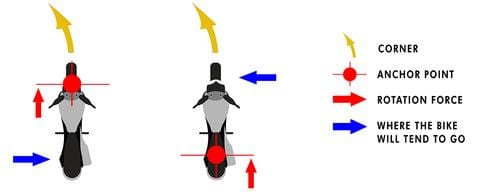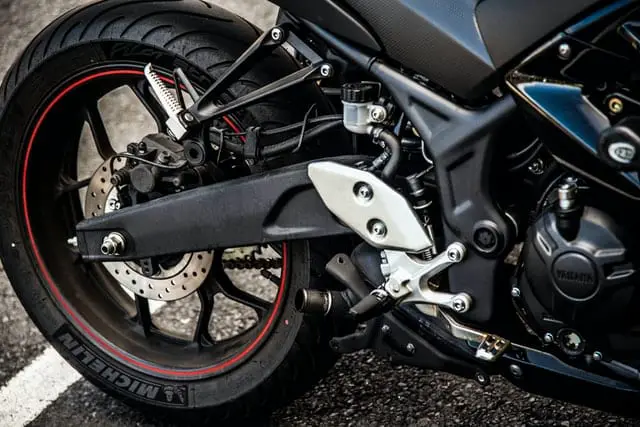Why do cars have a single brake but motorcycles need two separate brakes? If that came to your mind, then you are not alone – so many people are thinking the same but never took the time to search it up.
Pat yourselves in the back for finding this article. Your job is almost done, now just sit back and relax – while I tell you why exactly the motorcycle uses two separate brakes.
For a quick answer – motorcycles need two separate brakes (front and rear) primarily because two brakes give the riders much more control in different use cases – front brake for stopping and rear wheel for control and maneuvering.
I will cover all the different scenarios in this article. Why does the rear wheel of a motorcycle tend to skid? In which scenarios should you use just the front brake? Or rear? Or both?
All that coming up right now.
7 Reasons Why Motorcycles Have Two Separate Brakes
1. More Control
Two wheelers like a motorcycle are much harder to ride and control – you need to constantly keep balance.
When riding, there are many factors and scenarios that could make your wheels lose grip – causing you to fall over. Different brakes allow you to control these factors.
Here’s an example scenario – when riding on a slippery surface (like a muddy off-road), suddenly locking the front wheel too hard can cause it to lose traction and skid – making you fall over.
In such a scenario, you should go slower and rely more on the rear wheel rather than the front.
Another scenario – when you are riding very slowly and have to make sharp turns (like a U-Turn in tight spaces), you wouldn’t want to lock the front wheel and risk tipping over.
In this scenario, you should again rely more on the rear wheel rather than the front.
There are many more scenarios where you should use either the front or rear wheel. I will talk more about this later.
For now, understand that two separate brakes on a motorcycle gives you more control on different scenarios to maneuver and stay up. Cars obviously don’t have this problem because you wouldn’t trip and fall over.
2. Prevents Skidding
In a motorcycle, rear wheels tend to skid much more than the front. This happens because as you brake (no matter front or rear), the majority of weight is transferred over to the front wheel.
Specifically, this is caused by inertia. When riding a motorcycle, your body and the bike are moving forward at speed. Braking creates inertia from your body and your bike to still apply some force forward (to the front wheels).
The good news is – with two separate brakes, you can control exactly which break to use. Generally, the front brake is used to stop whereas the rear brake is used for control and maneuvering. Relying on the rear brake to stop will cause skidding.
3. Helps With Cornering
For advanced riders, using the right brakes can actually help with cornering. This works by creating an anchor point on the wheel.
Using the front brake while cornering will create an anchor point for the motorcycle on the front side, whereas the rear brake will create an anchor point on the rear side.
In simpler terms, applying rear brakes when cornering will make the turn sharper and easier. Whereas applying front brake when cornering will make the turn less sharp – suitable when you intend to slow down.

Motorcycle corner anchor point
5. Fail Safe
While riding a motorcycle, you are less protected than say riding a car – there are no airbags, no seat belts, etc.
This is why fail safe becomes much more important. For motorcycle riders, having two separate brakes means if one fails, the other one still functions.
This could mean life and death during accidents.
6. Humans Don’t Have Enough Grip
Pulling a single brake could get hard enough on some motorcycles. Pulling two brakes on a single lever would be even harder.
Humans don’t have such a strong grip to pull a single lever to lock up two wheels. If manufacturers focus on this feature, they probably could improve it and specifically design for single levers using hydraulic pressure.
7. Simpler Design
Two separate braking systems is a much simpler design than having a single braking system with one lever.
Lesser things could go wrong with a simpler system and you can fix them independently. Nothing much to say here.
8. Required By Law
In most countries like the United States and Canada, motorcycles (and even cars) are required by law to have two separate braking systems.
These laws are met differently though. In motorcycles, the lever on the handlebar is usually linked to the front brakes whereas the right foot pedal links to the rear brakes.
In cars, the foot pedal is linked to all 4 brakes and the handbrake is linked to the rear brakes – usually used only for parking.
When To Use Front Brake Vs Rear Brake On Motorcycle
So far, I have been talking about how you should use different brakes for different scenarios – so what scenarios are these really?
You should first know that front brakes are really effective for stopping, whereas rear brakes are effective for control and maneuvering.
But no matter the brakes, you shouldn’t grip at the brakes too tightly or too promptly. This can cause a lockup and risk you falling. It’s best to progressively squeeze the brake from gentle to firmer – allowing the wheel to progressively slow down.
If you feel a lockup is coming, immediately release your brake and reapply the brake again. That said here are different scenarios for each brake.
Scenarios when to use the front brakes:
- Quickly slowdown or stopping to a halt. When you brake, the weight of your body and the bike will transfer forward – providing more grip and traction on the front wheel. This is great for stopping.
Scenarios when to use the rear brakes:
- Riding on extremely slow speed at tight spaces. Your bike needs to always move to stay balanced. When moving at extremely slow speed, you shouldn’t use the front brake because it can easily lock up your wheel, put your bike to a halt and risk you falling over.
- Riding on slippery or muddy roads. When riding on slippery roads, using the front brake can risk locking up the wheel and have it skid forward – this is dangerous. Instead, you should use the rear brake on slippery roads – this causes the rear wheel to stay in contact with the road and reduce the chances of skidding.
Scenarios when to use both brakes simultaneously:
- Emergency brake. If you need to come to a halt immediately, using both brakes at the same time is your best bet. Nothing much to say here.
- Beginner riders. For beginner riders, using both the brakes simultaneously is the best. Most accidents come from locking up the front wheel. Using both brakes can reduce the chances for these accidents.
Do Combined Brakes Exist?
Yes, combined brakes exist in motorcycles – these are usually equipped in modern bikes with Anti-Lock Braking System (ABS)
ABS as the name suggests, help to prevent wheel locks on your bikes. They make use of speed sensors and motorcycles to identify when should pressures be lifted or applied on brakes – prevent locking.
Speed sensors determine the moments when a wheel is about to lock and the computer decides whether to lift or apply pressure on the brakes.
With ABS, both brakes in motorcycle are connected and the decision to brake on the rear or front is left to the computer.

